1.2 Symptoms and signs of infection
Symptoms are sensations in the body that only the person who is unwell can experience; for example, a headache, pain in the abdomen, blurred vision and nausea are all symptoms, because no one but the sufferer can experience them. Lay people, including children, can usually describe their symptoms accurately or report them if asked the right questions, but symptoms are subjective experiences that others cannot observe or verify.
By contrast, the signs of a disease are indicators of illness that other people can observe (e.g. a runny nose and frequent sneezing). Considering the symptoms and signs together may give enough information for a trained health worker to make a diagnosis, i.e. identify the underlying cause of the illness and give it a definite name. An example will illustrate this point.
You probably agree that the children in Figure 2 look ill, but how did you decide this?
What signs of disease can you identify from their photographs? Did the name of any infectious diseases spring to mind when you looked at these children?
We expect that you noted the numerous tiny red spots on the children’s faces and shoulders and that their eyes look sore. Some of you (especially if you have children or much younger siblings) may have wondered if the cause could be roseola, or perhaps chickenpox or measles?
A trained health worker would first note the rash and sore eyes and ask the caregivers about other observable signs of disease, for example ‘Does the child have a cough or a fever?’ However, these signs alone are not enough to make a diagnosis. In this example, the health worker would look for clusters of tiny white spots inside the mouth (so-called Koplik spots), which are not always present, but if visible are a definite sign of measles. Combining all the information leads to the diagnosis that the children in Figure 2 do in fact have measles – an infectious disease caused by a virus.
However, it should not be assumed that only trained health workers can diagnose an illness. Most adults and parents at some stage make a ‘good enough’ diagnosis of what ails them or their children. Lay people very often decide on the basis of their own symptoms or the signs of disease they observe in family members whether to treat an illness at home with simple remedies, or seek advice from a trained health worker.

